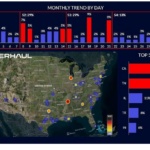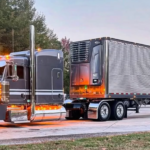Mandated by the federal government, electronic logging devices automatically monitor how long commercial drivers have been behind the wheel.
- Electronic logging devices (ELDs) are used on commercial vehicles to, among other things, record how long drivers are on the road.
- ELDs are required by law to be used by many commercial vehicles with engines that have been manufactured in the model year 2000 or later.
- Businesses that don’t abide by the federal ELD mandate are subject to a range of penalties and fines.
Driving trucks or company-owned vehicles can be a dangerous job. In an effort to create a safe work environment for drivers, many businesses that operate a fleet of vehicles are required to have electronic logging devices (ELD) installed in their trucks and busses. If your business has a fleet of vehicles, it is important to have a clear understanding of what an ELD is, how they operate, their benefits and who is required to use them.
What is an electronic logging device (ELD)?
An electronic logging device (ELD) is a device that automatically records driving time and hours of service (HOS) records for drivers of commercial motor vehicles. It also records data on the vehicle’s engine, movement and miles driven. Truck drivers, fleet managers, and dispatchers can use the ELD’s real-time information about the driver’s status to ensure fleet compliance with industry regulations, support planning of schedules, and adherence to required inspections.
To obtain all of this information, ELDs are connected to the vehicle’s engine. Information from those devices is then automatically uploaded into fleet management software.
ELD rule
The federal ELD mandate, which is part of the Federal Highway Administration’s MAP-21 Act, requires that commercial drivers use ELDs when they are required to prepare HOS records of duty status (RODS). The rule sets performance and design standards for ELDs, which must be certified and registered with the Federal Motor Carrier Safety Administration (FMCSA), and determines what documents drivers must keep to meet the rule.
What do ELDs do?
The ELD connects to the commercial motor vehicle’s engine and records driving time to track HOS. It automatically records driving activity, miles driven, engine hours, ignition status, location, and other key data points (e.g., date, time, driver ID, user authentication).
The ELD sends engine and GPS location data to the fleet company’s main server, creates duty status logs, and sends the information to the ELD’s mobile app for drivers and fleet managers to view. The device continually updates this information to provide reports in real time.
Drivers, dispatchers and fleet managers can use the ELD’s mobile app on their smartphone or tablet to access electronic logging information. The mobile app syncs with fleet management software to produce ELD reports, maps, and notifications for fleet and compliance managers.
Features
The FMCSA mandates that ELDs must:
- Be registered with the FMCSA
- Have manufacturer certification
- Meet specific technical specifications
Many ELDs consist of a device that includes a preloaded mobile app. The carrier can also use a bring your own device (BYOD) solution that works with their hardware.
The ELD needs to be able to:
- Synchronize with the engine control module
- Automatically record driving time and details
- Record location via GPS technology
- Support electronic data transfer (e.g., wireless, email, USB, Bluetooth)
- Prevent tampering with the device
- Support certification of driver records (every 24 hours)
- Display report for safety officials (on screen or paper)
Potential uses for ELDs
Fleet owners use ELDs to record their drivers’ drive time and electronically track HOS time as per the FMCSA’s ELD rule. Since ELDs record a lot of data in addition to driver logs, fleet owners can use them to support their fleet management system. Companies across many different industries can use ELDs, and the data they collect, to support various strategies and applications, including:
- Compliance: ELDs electronically record HOS and duty status in electronic logs. This ensures their vehicles comply with the FMCSA’s ELD mandate. It also removes the need to maintain paper logs.
- Safety: Modern ELDs include built-in accelerometers and gyroscopes that enable the detection of certain types of “harsh events” (e.g., collisions, hard braking, severe turns). Fleet managers can use historical data to identify where events occurred, train drivers on safer driving practices and back up drivers in cases where they are falsely accused of causing accidents.
- Dispatch and routing: ELDs include built-in GPS devices that provide real-time location data when drivers are on the road. Fleet managers and dispatchers can use this information to determine where their vehicles are at all times. They can also use the data to plan more efficient routes and help drivers avoid traffic congestion.
- Reporting: Fleet managers can produce numerous reports using data collected from They can use these reports to improve efficiency and cost-saving opportunities. For example, reports can focus on idle time, rising fuel costs, risky driving behavior, unusually long delivery times and other events tied to specific drivers or vehicles.
- Maintenance: ELDs connect to the vehicle’s onboard diagnostics port, which allows it to access critical engine data (e.g., fault codes, mileage). This enables fleet managers to schedule preventative maintenance and quickly respond when repairs are required. Drivers can also submit electronic driver vehicle inspection reports (DRIRs) via the ELD’s mobile app. This is more efficient than filling out paperwork, saving time for the driver and the administrative staff.
- Geofencing:Some ELDs come with geofencing capabilities, which can use acquired data to improve security and reduce financial loss. Geofencing allows the fleet manager to create virtual boundaries around real-world physical locations (e.g., a shipping yard, terminal, parking area, bridge). The software can be programmed to send alerts when a vehicle enters or exits the geofenced area, allowing the fleet manager to react to security issues, thefts or drivers entering prohibited areas.
Who uses ELDs?
The ELD rule applies to commercial motor vehicles. The FMCSA defines commercial motor vehicles as “any self-propelled or towed motor vehicle used on a highway in interstate commerce to transport passengers or property when the vehicle” that meets one or more of the following criteria:
- It has a gross vehicle weight rating or gross combination weight rating, or gross vehicle weight or gross combination weight, of at least 4,536 kg (10,001 pounds), whichever is greater
- It is designed or used to transport more than eight paid passengers, including the driver
- It is designed or used to transport more than 15 unpaid passengers, including the driver
- It is used to transport hazardous material as per 49 USC 5103 in a quantity that requires placarding under regulations as per 49 CFR, subtitle B, chapter I, subchapter C
Additionally, commercial motor vehicle drivers who are required to maintain RODS for at least eight days out of 30 days must use an ELD. Drivers who fail to follow the ELD rule are subject to a range of penalties and fines, including being put out of service for 10 hours.
Exemptions
Drivers who do not have to keep RODS logs are not required to have an ELD on their vehicle. The FMCSA also exempts drivers from having an ELD in their vehicle if they:
- Operate vehicles with engines made before the year 2000
- Use RODS for no more than eight days within 30 days
- Are driveaway-towaway drivers, where the vehicle they drive is part of the shipment
- Qualify under short-haul exceptions and are not required to keep RODS
- Transport livestock or insects
What are the benefits of ELDs?
The main benefit of ELDs is that they help to improve driver safety. ELDs ensure that drivers and fleet owners comply with HOS regulations, which serves to prevent and reduce driver fatigue.
ELDs provide additional benefits for fleet owners and carriers, including:
- Simplifying the process of keeping RODS
- Automating the RODS process to ensure HOS compliance
- Reducing overall paperwork
- Saving the time and resources spent on administrative tasks
- Employing automated tracking to reduce the risk of errors
Open platform telematics
ELDs that use open platform telematics technology provide a number of benefits, including the ability to:
- Provide access to real-time data that can be used to improve fleet productivity and efficiency
- Monitor fuel use and efficiency
- Produce reports of engine faults, which supports proactive vehicle maintenance
- Report vehicle inspections
- Support mileage reporting for fuel tax and International Registration Plan
- Scan receipts and invoices
Source: www.businessnewsdaily.com




